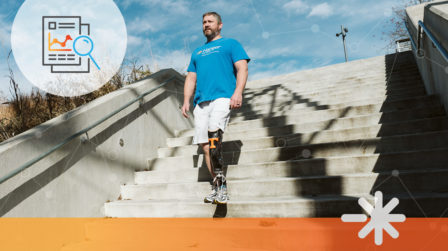Up-to-date information about Hanger Clinic’s response
Mobility Analysis of AmpuTees (MAAT)
Restoring mobility and building a patient-focused future through evidence-based holistic care.
The prevalence of lower limb amputations in the United States continues to rise with a projected population of 3.6 million amputees by 2050, up from 1.6 million in 2005.1 Accompanying the rise in patients is a shift in healthcare policies that place increased emphasis on patient-centered outcomes as they relate to prosthetic mobility.2,3 While prosthetic rehabilitation has traditionally focused on restoring functional mobility, there is now a need to go beyond that and better understand the impact of improved mobility holistically.
Mobility Analysis of AmpuTees (MAAT)
MAAT is comprised of six separate landmark studies that represent one of the largest multicenter retrospective analyses of mobility among users of lower limb prostheses. The series seeks to clarify the concept of prosthetic mobility as it relates to such considerations as satisfaction, quality of life, comorbid health conditions, and prosthetic component choices.
MAAT 1
Quality of life and satisfaction are strongly related to mobility for patients with a lower limb prosthesis
Prosthetics and Orthotics International, October 8, 2017
Download the publication
MAAT 2
Comorbidities and mobility in lower limb prosthesis users
American Journal of Physical Medicine & Rehabilitation, November 2018
Download the publication
MAAT 3
Matching individuals based on comorbid health reveals improved function for above-knee prosthesis users with microprocessor knee technology
Assistive Technology The Official Journal of RESNA, December 2018
Download the publication
MAAT 4
Classification tree analysis for probability of lower limb prosthesis user functional potential
Assistive Technology The Official Journal of RESNA, February 2019
Download the publication
MAAT 5
Impact of five common prosthetic ankle-foot categories for individuals with diabetic/dysvascular amputation
Journal of Rehabilitation and Assistive Technologies Engineering, February 2019
Download the publication
MAAT 6
Mobility, Satisfaction, and Quality of Life among Long-Term Dysvascular/Diabetic Prosthesis Users–Results of a Cross-Sectional Analysis
Journal of Prosthetics and Orthotics, February 2020
Download the publication
- Ziegler-Graham K, MacKenzie E, Ephraim P, et al: Estimating the prevalence of limb loss in the United States: 2005 to 2050. Arch Phys Med Rehabil 2008;89:422–9.
- Patient Centered Outcomes Research Institute, http://www.pcori.org (accessed July 2017).
- Patient-reported outcomes measurement information system. National Institutes of Health Office of Strategic Coordination—the common fund, https://commonfund.nih.gov/promis/index (accessed July 2017).
Clinical Outcomes
The MAAT series stems from the adult lower limb prosthetic clinical outcomes protocol currently utilized by Hanger Clinic.




